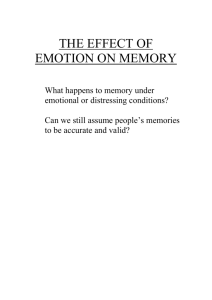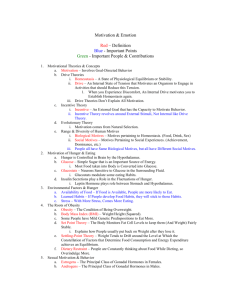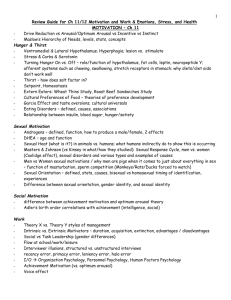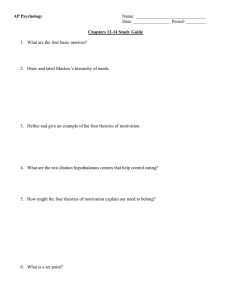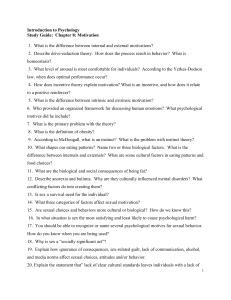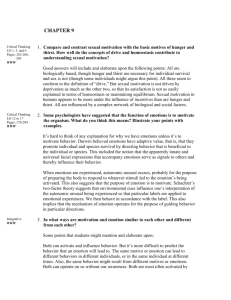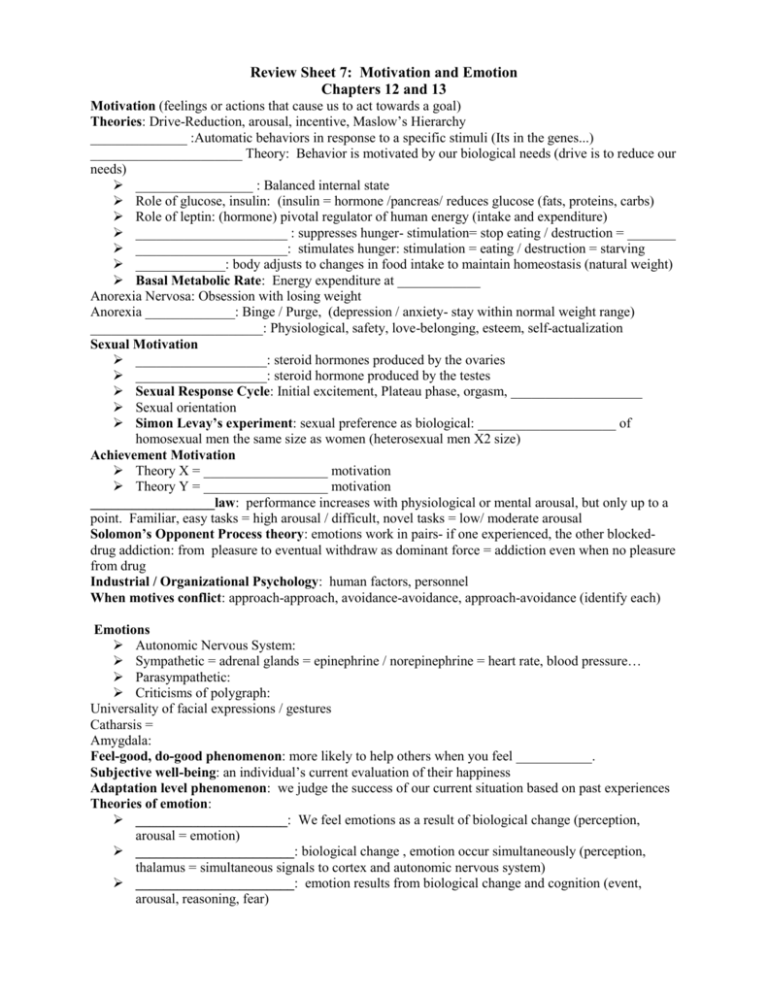
Review Sheet 7: Motivation and Emotion
Chapters 12 and 13
Motivation (feelings or actions that cause us to act towards a goal)
Theories: Drive-Reduction, arousal, incentive, Maslow’s Hierarchy
______________ :Automatic behaviors in response to a specific stimuli (Its in the genes...)
______________________ Theory: Behavior is motivated by our biological needs (drive is to reduce our
needs)
_________________ : Balanced internal state
Role of glucose, insulin: (insulin = hormone /pancreas/ reduces glucose (fats, proteins, carbs)
Role of leptin: (hormone) pivotal regulator of human energy (intake and expenditure)
______________________ : suppresses hunger- stimulation= stop eating / destruction = _______
______________________: stimulates hunger: stimulation = eating / destruction = starving
_____________: body adjusts to changes in food intake to maintain homeostasis (natural weight)
Basal Metabolic Rate: Energy expenditure at ____________
Anorexia Nervosa: Obsession with losing weight
Anorexia _____________: Binge / Purge, (depression / anxiety- stay within normal weight range)
_________________________: Physiological, safety, love-belonging, esteem, self-actualization
Sexual Motivation
___________________: steroid hormones produced by the ovaries
___________________: steroid hormone produced by the testes
Sexual Response Cycle: Initial excitement, Plateau phase, orgasm, ___________________
Sexual orientation
Simon Levay’s experiment: sexual preference as biological: ____________________ of
homosexual men the same size as women (heterosexual men X2 size)
Achievement Motivation
Theory X = __________________ motivation
Theory Y = __________________ motivation
__________________law: performance increases with physiological or mental arousal, but only up to a
point. Familiar, easy tasks = high arousal / difficult, novel tasks = low/ moderate arousal
Solomon’s Opponent Process theory: emotions work in pairs- if one experienced, the other blockeddrug addiction: from pleasure to eventual withdraw as dominant force = addiction even when no pleasure
from drug
Industrial / Organizational Psychology: human factors, personnel
When motives conflict: approach-approach, avoidance-avoidance, approach-avoidance (identify each)
Emotions
Autonomic Nervous System:
Sympathetic = adrenal glands = epinephrine / norepinephrine = heart rate, blood pressure…
Parasympathetic:
Criticisms of polygraph:
Universality of facial expressions / gestures
Catharsis =
Amygdala:
Feel-good, do-good phenomenon: more likely to help others when you feel ___________.
Subjective well-being: an individual’s current evaluation of their happiness
Adaptation level phenomenon: we judge the success of our current situation based on past experiences
Theories of emotion:
______________________: We feel emotions as a result of biological change (perception,
arousal = emotion)
_______________________: biological change , emotion occur simultaneously (perception,
thalamus = simultaneous signals to cortex and autonomic nervous system)
_______________________: emotion results from biological change and cognition (event,
arousal, reasoning, fear)




